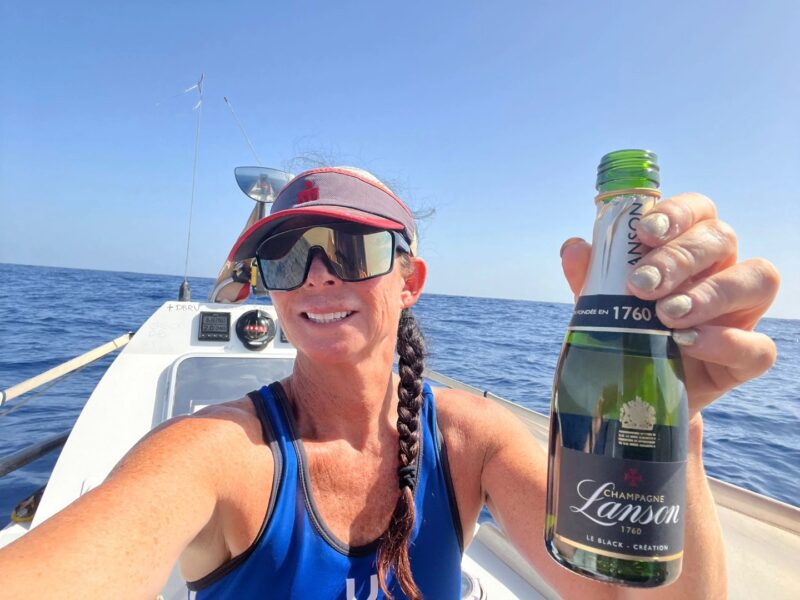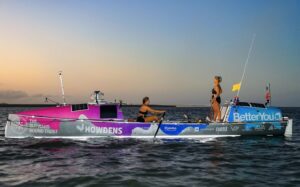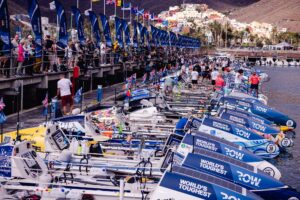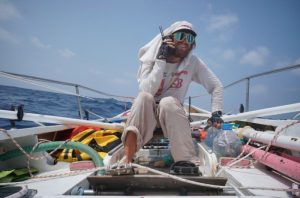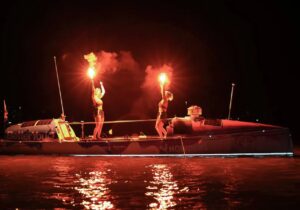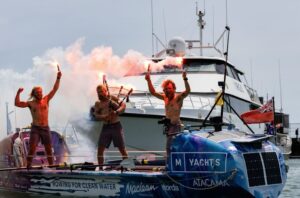Since our last rowing roundup, there have been two rescues, two female soloists have taken to the water, and several crews are about to finish.
Linda Blakely: Linda Blakely (UK) is crossing the Atlantic from east to west. She started on Jan. 20 in the Canary Islands and is heading to St. Lucia. So far, she has covered just over half of the 5,000km distance. Though she has not rowed before, Blakely is no stranger to physical challenges. She previously summited Everest and Lhoste within a day, has won Ironman competitions, and has represented Great Britain in triathlons.
Now, the athlete is aiming to become the fastest woman to cross the Atlantic solo. So far, however, Blakely is making slower progress than expected. She capsized and lost her spare oars during difficult conditions in the first week. Then there was so little wind that she barely moved. Now conditions have settled, and she has picked up the pace.
The return of Ellen Magellan
Ellen Falterman: Ellen Falterman (U.S.) has restarted her rowing expedition. “Ellen Magellan,” as she calls herself, is attempting to row around the world. If she succeeds, she will become the first person to complete a circumnavigation entirely by rowing. She initially set off in September 2022. From East Texas, she followed the Gulf Intracoastal Waterway to the Florida Panhandle. Then she crossed the Gulf of Mexico to South Florida. Here, she put her journey on hold because of several family bereavements.

Photo: Ellen Falterman
More than a year later, she has returned to the water. On Feb. 8, she set off from Sarasota, Florida, where she ended her row in 2022. She is now trying to make it to Kusapin, Panama.
The first two weeks have been quite challenging. At some points, the tailwinds have been too strong to control the boat properly. Falterman is determined to keep going but admits that she does not know what the row to Panama will bring, or how long it will take.
A challenging route
On her blog, she wrote, “Texas to Panama has been my mantra for three years now. I am aware there are logistical problems with this route. [Some] people have let me know –- some nicely, some quite rudely –- that rowing from Texas to Panama is a stupid idea, an impossible route in a rowboat, and I’m a dumb, silly woman for even considering it. These people, however, have not tried this route in a rowboat. Nobody has.”
Pete Beatty: Pete Beatty (UK) aborted his bid to row the Atlantic on Jan. 26. Consistently strong winds on the journey from Portugal to French Guiana left him on the para-actor for days at a time. Once he capsized after a large wave hit the side of his boat.
An almost constant headwind made progress difficult, and conditions showed no signs of improvement. When a short window opened up, he made it past Lanzarote, one of the Canary Islands. Then disaster struck. A huge wave snapped one of his oars in half. With the good weather ending, and unable to fix the oar or make it to shore, Beatty summoned help and was rescued by air.

Photo: Pete Beatty
Decides to abort
After resting on Lanzarote for a few days, he decided not to continue. “It wasn’t the fear of the boat capsizing, or me ending up under the water,” he wrote on social media, “but rather the realization that my life is worth much more than…reaching French Guiana.”
Oar Blimey: This duo is rowing from Sagres, Portugal to St. Martin. They set off on Dec. 1 and have now been at sea for almost three months. As with everyone on the Atlantic in December and January, they struggled against the strong winds, which slowed their pace dramatically.
Unable to make up the lost time, they started rationing their food in early February. They cut their daily intake from 5,000 calories each down to 3,000 calories. Even without a scale, they say that it is clear how much weight they’re shedding.

Photo: Oar Blimey
Change of route
Yesterday they decided to change their route to nearby Antigua.
“Not only will this reduce the distance by [130km], but more importantly, it’ll get us across the Atlantic three days sooner,” they wrote. “Rerouting allows us to once again enjoy a higher daily calorie intake.”
The extra energy will help them navigate from the Atlantic currents into the Caribbean.
They will now shift slightly south while maintaining a general westward direction toward Antigua. They have 1,050km left and hope to cover it in three weeks.
Piotr Pawelec: Pawelec (Poland) is rowing from Portugal to Guadeloupe. After 20 days, he stopped for a few weeks in Gran Canaria to rest, resupply, and make repairs. He then continued to Guadeloupe.
Pawelec has shared almost no updates on his journey, but his tracker shows that he has almost finished. He has covered 5,315km.
Round the world
Louis Margot: Margot (Switzerland) is rowing from Portugal to Costa Rica. The row is part of a much larger, round-the-world expedition by rowing and cycling.
After biking from Switzerland to Portugal, he began his first rowing leg. He started on Oct. 9 but temporarily stopped after five days because of difficult weather. He restarted on Nov. 6. After 19 days, he landed briefly in Gran Canaria to resupply and make adjustments to his boat. He then continued toward Costa Rica.
Margot recently decided to adjust his route. Instead of landing in Costa Rica, he will make a second pitstop on the island of Martinique. He wants to reach there on March 2, to celebrate his birthday with his family.
No more SUP
Gabor Rakonczay: Gabor Rakonczay (Hungary) completed his row across the Atlantic on Jan. 26. The Hungarian adventurer unsuccessfully attempted the crossing twice before, on a SUP.
Both ended in disaster. In 2020, he abandoned the crossing after three days when water penetrated his hull. A year later, he had to be rescued after six days. In trying to keep his SUP as traditional as possible, his vessel did not have an enclosed sleeping area. Rakonczay simply strapped himself to the deck at night.
This did not work at all. He was constantly soaked to the skin and unable to sleep. Eventually, he began to hallucinate. He had the urge to remove his life jacket and throw himself into the water. Luckily, he came to his senses, inflated his emergency life raft, and called for rescue.

Photo: Gabor Rakonczay
His attempt to row a boat rather than SUP was more successful, but it was not easy. The winds made it incredibly arduous. The most difficult section was navigation during the last few days so that he could land correctly. On the penultimate day, Rakonczay rowed for 22 hours and had to overcome problem after problem.
“I have just been pushing through to the island in the strong waves coming almost from the side all day,” he wrote. “The boat lay on its side every half an hour and capsized four times. Once, I fell into the water and broke my finger.”
‘World’s Toughest Row’
The World Toughest Row: The famous race (previously the Talisker Whisky Atlantic Challenge) across the Atlantic has entered its final stages. All crews set off from Tenerife on Dec. 13. The winners — the five-man Oardacious crew — reached Antigua on Jan. 17 after 35 days, 4 hours, and 30 minutes at sea.

Interpid232’s Rosemary Satchwell, Alison Smithurst, Julie Brady, and Helene Monpetit finished in 58 days, 12 hours, and 30 minutes. Photo: World’s Toughest Row
Now just three crews remain on the water. All are just days from finishing. As always with this race, different crews vie for category wins and records. Here are the stats from the 2023-4 crews:
Overall Winner: HMS Oardacious
Fastest five: HMS Oardacious (35 days 4 hours, and 30 minutes)
Fastest four: Team Out of the Blue (36 days 11 hours, and 5 minutes)
Fastest trio: Blue Tusk (38 days 18 hours, and 29 minutes)
Fastest pair: Spirit of Hospitality (38 days 15 hours, and 3 minutes)
Fastest soloist: The Entrepreneurship (42 days, 3 hours, and 15 minutes)
Records
Oldest men’s pair to cross any ocean: Never 2 Late (66 days 17 hours, and 39 minutes)
Oldest soloist to cross any ocean: Frank Rothwell (64 days 7 hours, and 53 minutes)
Oldest female four to cross any ocean: Intrepid232 (58 days, 12 hours, and 30 minutes)
Fastest women’s pair to cross the Atlantic: Team Ocean Grown (45 days, 1 hour, and 27 minutes)
Fastest women’s trio to cross the Atlantic: Wave Breakers (40 days 10 hours, and 51 minutes)
Atlantic Dash
The Atlantic Dash: The Atlantic Dash is a second, smaller organized event on the Atlantic. The organizers half-stress that this is not a race: “However, we are not your mum, if you want to be the first to Antigua, race on!”
This year’s field now consists of just two crews. Three started, but Destiny’s Tide pulled out after 17 days. The crews make a very similar journey to those in the larger World’s Toughest Row. They also begin in the Canary Islands, but from Lanzarote rather than Tenerife. They row to Antigua. So far, the race positions are:
The Brightsides: This four has held a steady lead for most of the race. Rod Adlington, Anna Williams, Alex Perry, and Guy Minshull have covered 5,115km and are expected to land in four days.
Atlantic Rocks: Phil Angus, Gary Binns, Justin Wallace, and Dan Martin are in second place and should land 11 days after The Brightsides, on March 7. So far, they have rowed have covered 4,252km.

Destinys Tide. Photo: C-MAP Dash
Destiny’s Tide: A two-man crew made up of Neil Glover and Jason Black aborted on Jan. 20, after 1,205km. The pair lost both their rudder and daggerboard and were unable to continue.
They worked with the Coast Guard to organize a recovery. The merchant shipping vessel Lagoa picked them up and also agreed to tow their boat to Portugal.
